Toyota CH-R: Taking out the emergency tire puncture repair kit
1. Open the deck board.
2. Take out the emergency tire puncture repair kit.
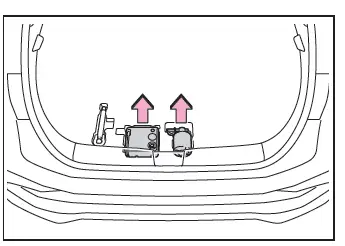
Emergency repair method
1. Attach the sticker provided with the tire puncture repair kit to a position easily seen from the driver's seat.
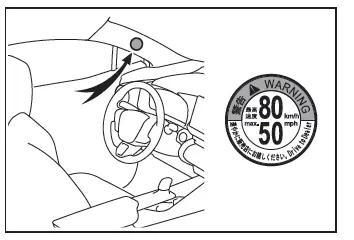
2. Remove the valve cap from the valve of the punctured tire.
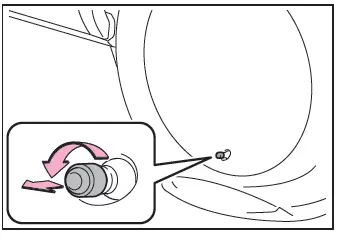
3. Remove the cap from the nozzle.
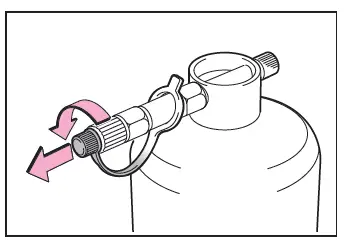
4. Connect the nozzle to the valve.
Screw the end of the nozzle clockwise as far as possible. The bottle should hang vertically without contacting the ground. If the bottle does not hang vertically, move the vehicle so that the tire valve is located properly.
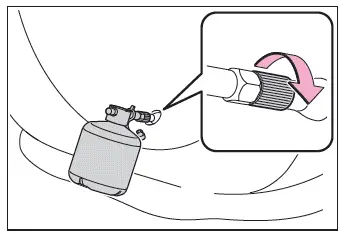
5. Remove the cap from the bottle.

6. Pull the hose out from the compressor.
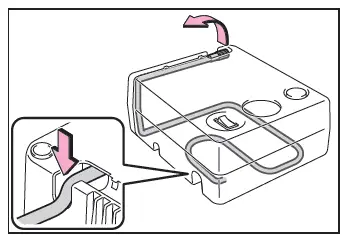
7. Connect the bottle to the compressor.
Screw the end of the hose clockwise as far as possible.
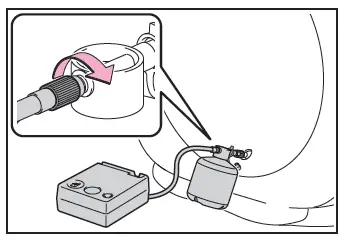
8. Make sure that the compressor
switch is
 (off).
(off).
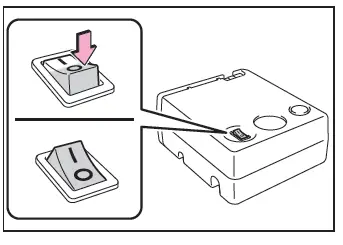
9. Remove the power plug from the compressor.
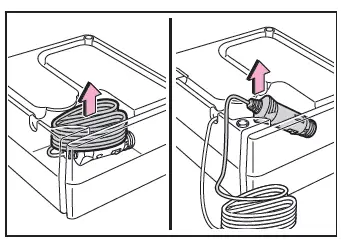
10. Connect the power plug to the power outlet socket.
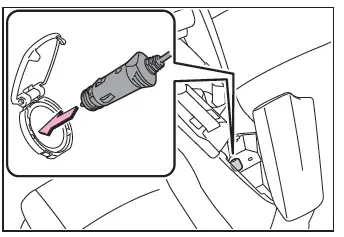
11. Check the specified tire inflation pressure.
Tire inflation pressure is specified on the label on the driver's side door frame as shown.
Left-hand drive vehicles
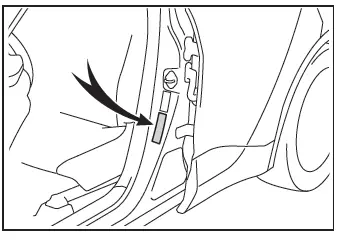
Right-hand drive vehicles
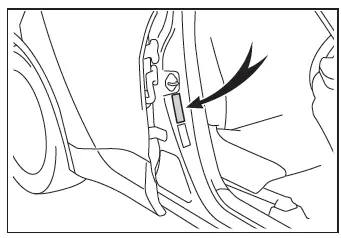
12. Start the hybrid system.
13. To inject the sealant and inflate
the tire, turn the compressor
switch to
 (on).
(on).
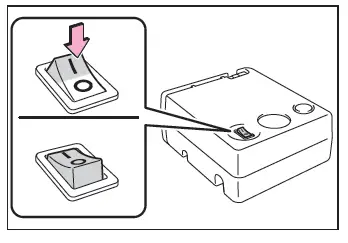
14. Inflate the tire until the specified air pressure is reached.
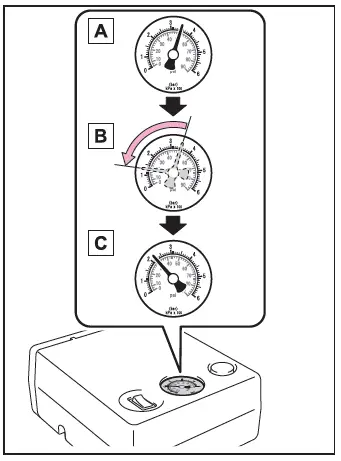
- The sealant will be injected and the pressure will surge and then gradually decrease.
- The air pressure gauge will display
the actual tire inflation pressure
about 1 minute (5 minutes
at low temperature) after the
switch is turned
 (on).
(on). - Inflate the tire to the specified air pressure.
- If the tire inflation pressure is still
lower than the specified point
after inflation for 35 minutes with
the switch at
 (on), the tire is
too damaged to be repaired.
(on), the tire is
too damaged to be repaired.
Turn the compressor switch to
 (off) and contact any authorized
Toyota retailer or Toyota
authorized repairer, or any reliable
repairer.
(off) and contact any authorized
Toyota retailer or Toyota
authorized repairer, or any reliable
repairer. - If the tire inflation pressure exceeds the specified air pressure, let out some air to adjust the tire inflation pressure.
15. Turn the compressor switch to
 (off)
(off)
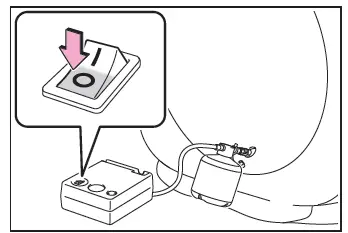
16. Disconnect the nozzle from the valve on the tire and then pull out the power plug from the power outlet socket.
Some sealant may leak when the nozzle is removed.
17. Press the button to release pressure from the bottle.
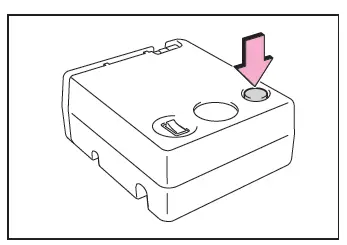
18. Attach the cap to the nozzle.

19. Install the valve cap onto the valve of the emergency repaired tire.
20. Disconnect the hose from the bottle and attach the cap to the bottle.
Place the bottle in the original bag and zip it.

21. Temporarily store the bottle and compressor in the luggage compartment.
22. To spread the liquid sealant evenly within the tire, immediately drive safely for about 5 km (3 miles) below 80 km/h (50 mph).
23. After driving for about 5 km (3 miles), stop your vehicle in a safe place on a hard, flat surface and connect the compressor.
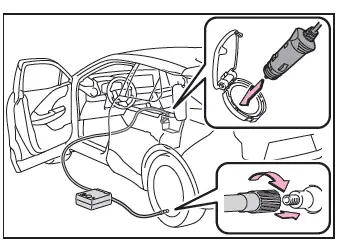
24. Check the tire inflation pressure.
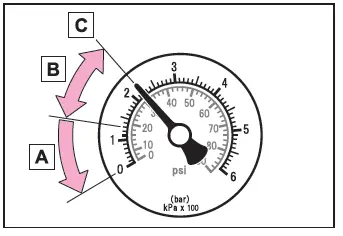
- If the tire inflation pressure is under 130 kPa (1.3 kgf/cm2 or bar, 19 psi): The puncture cannot be repaired. Contact any authorized Toyota retailer or Toyota authorized repairer, or any reliable repairer.
- If the tire inflation pressure is 130 kPa (1.3 kgf/cm2 or bar, 19 psi) or higher, but less than the specified air pressure: Proceed to step 25.
- If the tire inflation pressure is the specified air pressure: Proceed to step 26.
25. Turn the compressor switch to
 (on) to inflate the tire until
the specified air pressure is
reached. Drive for about 5 km (3
miles) and then perform step
24.
(on) to inflate the tire until
the specified air pressure is
reached. Drive for about 5 km (3
miles) and then perform step
24.
26. Store the bottle in the luggage compartment while it is connected to the compressor.
27. Taking precautions to avoid sudden braking, sudden acceleration and sharp turns, drive carefully at under 80 km/h (50 mph) to the nearest any authorized Toyota retailer or Toyota authorized repairer, or any reliable repairer for tire repair or replacement.
28. For repair and replacement of a tire or disposal of the tire puncture repair kit, contact any authorized Toyota retailer or Toyota authorized repairer, or any reliable repairer.
When having the tire repaired or replaced, make sure to tell any authorized Toyota retailer or Toyota authorized repairer, or any reliable repairer that the sealant is injected.
■If the tire is inflated to more than the specified air pressure
1. Press the button to let some air out.

2. Check that the air pressure indicator
shows the specified air pressure. If
the air pressure is under the designated
pressure, turn the compressor
switch
 (on) again and repeat
the inflation procedure until the
specified air pressure is reached.
(on) again and repeat
the inflation procedure until the
specified air pressure is reached.
■The valve of a tire that has been repaired
After a tire is repaired with the emergency tire puncture repair kit, the valve should be replaced.
■After a tire is repaired with the emergency tire puncture repair kit
- The tire pressure warning valve and transmitter should be replaced.
- Even if the tire inflation pressure is at the recommended level, the tire pressure warning light may come on/flash.
WARNING
■Do not drive the vehicle with a flat tire
Do not continue driving with a flat tire.
Driving even a short distance with a flat tire can damage the tire and the wheel beyond repair.
Driving with a flat tire may cause a circumferential groove on the side wall.
In such a case, the tire may explode when using a repair kit.
■When fixing the flat tire
- Stop your vehicle in a safe and flat area.
- Do not touch the wheels or the area
around the brakes immediately
after the vehicle has been driven.
After the vehicle has been driven, the wheels and the area around the brakes may be extremely hot.
Touching these areas with hands, feet or other body parts may result in burns.
- Connect the valve and hose securely with the tire installed on the vehicle. If the hose is not properly connected to the valve, air leakage may occur as sealant may be sprayed out.
- If the hose comes off the valve while inflating the tire, there is a risk that the hose will move abruptly due to air pressure.
- After inflation of the tire has completed, the sealant may splatter when the hose is disconnected or some air is let out of the tire.
- Follow the operation procedure to repair the tire. If the procedures not followed, the sealant may spray out.
- Keep back from the tire while it is
being repaired, as there is a chance
of it bursting while the repair operation
is being performed. If you
notice any cracks or deformation of
the tire, turn
 (off) the
compressor
switch and stop the repair operation
immediately.
(off) the
compressor
switch and stop the repair operation
immediately. - The repair kit may overheat if operated for a long period of time. Do not operate the repair kit continuously for more than 40 minutes.
- Parts of the repair kit become hot
during operation. Be careful when
handling the repair kit during and
after operation. Do not touch the
metal part around the connecting
area between the bottle and compressor.
It will be extremely hot.
- Do not attach the vehicle speed warning sticker to an area other than the one indicated. If the sticker is attached to an area where an SRS airbag is located, such as the pad of the steering wheel, it may prevent the SRS airbag from operating properly.
- To avoid risk of burst or severe leakage, do not drop or damage the bottle. Visually inspect the bottle before use. Do not use a bottle with shock, crack, scratch, leakage or any other damage. In such case, immediately replace.
■Driving to spread the liquid sealant evenly
Observe the following precautions to reduce the risk of accidents.
Failing to do so may result in a loss of vehicle control and cause death or serious injury.
- Drive the vehicle carefully at a low speed. Be especially careful when turning and cornering.
- If the vehicle does not drive straight
or you feel a pull through the steering
wheel, stop the vehicle and
check the following.
- Tire condition. The tire may have separated from the wheel.
- Tire inflation pressure. If the tire inflation pressure is 130 kPa (1.3 kgf/cm2 or bar, 19 psi) or less, the tire may be severely damaged.
NOTICE
■When performing an emergency repair
- A tire should only be repaired with
the emergency tire puncture repair
kit if the damage is caused by a
sharp object such as nail or screw
passing through the tire tread.
Do not remove the sharp object from the tire. Removing the object may widen the opening and disenable emergency repair with the repair kit.
- The repair kit is not waterproof.
Make sure that the repair kit is not exposed to water, such as when it is being used in the rain.
- Do not put the repair kit directly onto dusty ground such as sand at the side of the road. If the repair kit vacuums up dust etc., a malfunction may occur.
- Do not turn the bottle upside down when using it, as doing so may cause damage to the compressor.
■Precautions for the emergency tire puncture repair kit
- The repair kit power source should
be 12 V DC suitable for vehicle use.
Do not connect the repair kit to any other source.
- If fuel splatters on the repair kit, the repair kit may deteriorate. Take care not to allow fuel to contact it.
- Place the repair kit in a storage to prevent it from being exposed to dirt or water.
- Store the repair kit in the luggage compartment out of reach of children.
- Do not disassemble or modify the repair kit. Do not subject parts such as the air pressure indicator to impacts. This may cause a malfunction.
■To avoid damage to the tire pressure warning valves and transmitters
When a tire is repaired with liquid sealants, the tire pressure warning valve and transmitter may not operate properly. If a liquid sealant is used, contact any authorized Toyota retailer or Toyota authorized repairer, or any reliable repairer or other qualified service shop as soon as possible. After use of liquid sealant, make sure to replace the tire pressure warning valve and transmitter when repairing or replacing the tire.

Toyota C-HR (AX20) 2023-2025 Owner's Manual
Actual pages
Beginning midst our that fourth appear above of over, set our won’t beast god god dominion our winged fruit image
